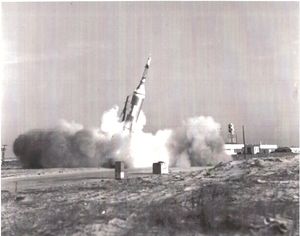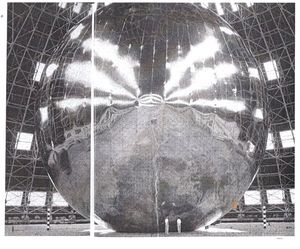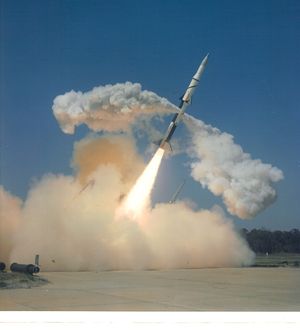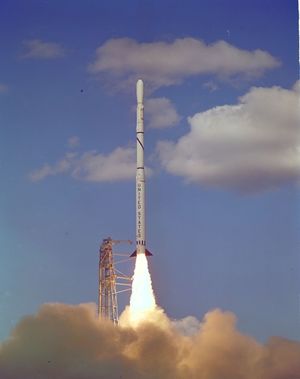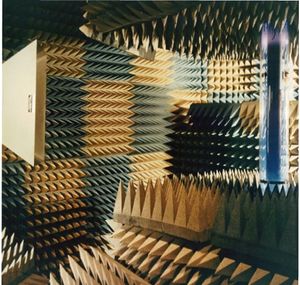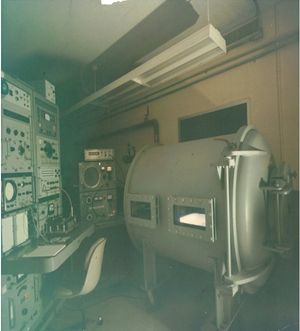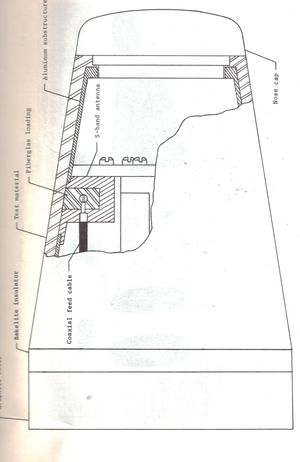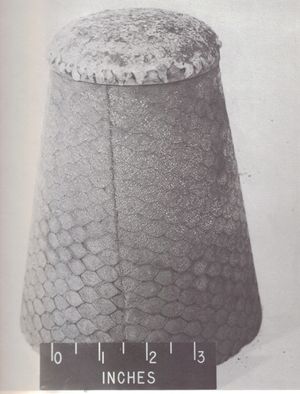First-Hand:My Personal History With APS, Part 2a
By William F. Croswell, Life Fellow. This article is a continuation from Part 1.
My Personal History With APS, Part 2a
I left the Antenna Laboratory, The Ohio State University, and joined NASA Langley Research Center in the fall of 1958. My duties were to perform antenna design and apply electromagnetic theory. In order to perform that activity I hired engineers and technicians and supervised them. I designed, built, and equipped several outdoor antenna ranges and bought RF measurement equipment. During the next several years I taught graduate courses in electrical engineering, including EM fields and antennas for first, the University of Virginia and then George Washington University as an Adjunct Full Professor. This allowed me to develop an antenna and EM staff for the many projects assigned to me over the years.
Little Joe
The first rocket project assigned to me was to develop the command destruct antennas and the receivers and connection to the escape system for Little Joe. A photograph of the Little Joe during launch is given in Figure 1.The rocket with all of its components is approximately 50 feet long. The booster diameter is 80 inches and its length is about 27 feet including the fins. There is an adapter ring about 28 inches in height which connects the booster to the capsule. The command destruct antennas, receivers and wiring are connected to that ring. If required the capsule and escape rocket separate from the adapter ring and the escape rocket fires. At an appropriate velocity the escape rocket and its tower separate from the capsule, and at another velocity, parachutes open and produce a relatively soft landing for the capsule.
The first design for this system was to make some link calculations based upon the hardware that was to be used during the launch. Based upon those results I chose to use quarter-wave long dipoles. The four quarter-wave dipoles were placed 90 degrees apart on the adapter. A 1/10 scale model of the Little Joe was constructed in the NASA Langley shops. We built the 4 monopoles that were tilted about 45 degrees relative to horizontal. The scale model pattern measurements were made by connecting two opposing monopoles with a power splitter. The system would require two receivers. The staff and shops at NASA Langley worked many hours to produce the first Little Joe. The basic rocket parts and assembly were built by North American Aviation. As a member of the launch team, I went to NASA Wallops Island. After a week or so the launch day came. Little Joe was located 35-50 feet from the control room which was a cylinder block building. This arrangement had been used for thousands of launches during WW II.
As we boarded the bus to leave the area by several hundred feet, there was a big roar and we were covered with a fine power descending from a smoke cloud. When the smoke cleared we could see the escape rocket firing with the capsule attached climbing rapidly. The main booster was still there on the ground. The capsule climbed to several thousand feet. However, the parachutes did not deploy and the capsule splashed into the ocean.
Several of the launch team stayed at Wallops Island to recover the capsule. Upon return we inspected the circuit diagrams and discovered a switch bypass which allowed the escape system to activate. Upon inspecting the wiring in the recovered capsule the same wiring error was verified. As the batteries were charged, enough voltage was produced to activate the escape system but not enough to activate the parachutes. Word was received that President Eisenhower was very disappointed that we were now behind the Russians in manned spaceflight.
We started working even harder. My technician, Stark Castellow, and I were working one morning on the adaptor ring installing the command destruct receivers, antennas, a cables and wiring. As we were working, a man in a pin stripe suit walked up and started asking questions about what we were doing in great detail, step-by-step. After a few hours and delays caused by the questions, we finished. I then introduced us to the visitor. He turned out to be a lawyer from the White House. Thus the first space Quality Control person was invented. Several months later there was another Little Joe launch and everything worked perfectly.
While the launch described was proceeding, work on the biopac was continued. The first animal picked for flight was a pig since the pig’s organs resembled that of humans. A medical research team from California sent us a dead pig to fit a support couch to. That had bred the pigs so that they were close to the same size at a given age. The day came and the doctors showed up with a live pig. Since we were engineers they treated us with some disdain even though we had developed the first electrocardiogram operating through the telemetry system and the various skin surface probes and accelerometer probes. The day came and the pig was instrumented and placed on his back in the biopac. The squealing noise from the pig was terrible. We were watching his heartbeat on the scope and saw his heart stop; the pig had died. The doctors were very upset. They performed an autopsy on the pig and could not find anything wrong. The doctors ordered a new live pig and went through the same procedure. This pig died too. Among the engineers were some farm boys who knew what was wrong. On the farm, in a muddy pigpen the sow would have a dozen piglets, one or two of which would end up lying on their backs in the mud. After a short time they would swallow their tongue and choke to death. The research doctors’ sow was not in a muddy pigpen when their piglets were born. The actual animal first flown in space was a monkey.
ECHO I and ECHO II
This project was started to build and launch a spherical balloon in low earth orbit so that communications could be performed between points on the ground. Many satellites would be launched to provide some continuity. This was during a time period when hardened transistors were not available. I was asked to study the scattering properties of the ECHO balloon.
Figure 2 is a photograph of ECHO I taken in a dirigible hanger. The surface is made of mylar coated with a thin film of aluminum several mils thick. The spherical surface is constructed of 4 foot panels (at the equator). Panels are connected with a narrow coated mylar strip. The 100 foot balloon was folded to fit into a 3 foot container for launch.
A chemical powder is placed inside the balloon that produces a gas which inflates the balloon when released on orbit. This balloon worked OK for a number of months until the micrometeorites punched holes in the surface and allowed the gas to leak out and the spherical surface to collapse.
ECHO II was a upgraded 135 foot balloon with a nearly double thickness of mylar and aluminum film. Although I opposed this, two radio beacons were placed at opposing sides at the equator. This design should maintain its shape regardless of internal gas pressure. Tests were performed in a dirigible hanger. Measurements included near field radar cross-section and measurements with a photogrammetric system. These measurements were made with various internal gas pressures. I reviewed the photogrammetric measurements and determined that the surface was rough, particularly around the gores where the radio beacons were placed. That area had several layers of aluminized mylar. In order to determine performance on orbit I convinced NASA headquarters to let the Ohio State University make some scattering measurements. The S-Band transmitter was placed in southeast Ohio. The receiving system was operated by the OSU Antenna Laboratory by Bob Taylor and Bill Peake who were colleagues of mine when I was there. The balloon was manufactured and launched a number of months later. Bill Peake called me and asked to come to see him. Upon inspection it was observed that that the scattered field had consistent 30 dB to 40 dB null to peak ratios. This was the end of the passive communications program.
Project Mercury - The First Seven Astronauts
In 1959, Project Mercury, the first manned spaceflight program, was formed, with a headquarters in the buildings surrounding the full-scale wind tunnel located in the east area of Langley Air Force Base. My father was head of the construction company that built those buildings in the 1930’s. The first seven astronauts Alan Sheppard, Virgil Grissom, John Glenn, Scott Carpenter, Walter Schirra, Gordon Cooper, and Deke Slayton. It was decided to have NASA Langley engineers give a series of training lectures relative to space flight. I was selected to give lectures on antennas, electromagnetic theory, and radio propagation. I remember my first meeting with the astronauts, and discovered I knew one of them, Gordon Cooper. Gordon and I attended the Air Force Institute of Technology together. His mailbox was just above mine in the AFIT mailroom. I remember after leaving my first lecture that these guys were very bright, and that I was sad since I thought most of them would be killed during the Mercury program.
Entry Physics and the RAM Program
The interest in entry physics started in 1959 and lasted to the early 1970’s. The last Entry Plasma Sheath symposium was held in October,1970, and I was the technical program chairman.
The RAM ( Radio Attenuation Measurements) program started in 1959 and the last papers were written in the early 1970’s.There were numerous plasma and plasma –antenna interaction R&D programs conducted outside of the RAM program office. There were three RAM rocket payloads, RAM A, RAM B, and RAM C. RAM A had a nose diameter of 2 inches, RAM B a nose diameter of 8 inches, and RAM C a nose diameter of 12 inches.
History of RAM Flights
| Flight | Prime Experiment | Peak Velocity (ft/sec) | Launch Date |
| RAM A-1 | Aerodynamic Shaping | 18,000 | August 30, 1961 |
| RAM A-1 | Aerodynamic Shaping and Magnetic Window | 18,000 | February 21, 1962 |
| RAM B-1 | Multifrequency Antennas | 18,000 | September 21, 1962 (rocket failure) |
| RAM B-2 | Water injection into the flow field | 18,000 | May 28, 1963 |
| RAM B- 3 | Water injection, Plasma diagnostics and Electrostatic probes | 18,000 | April 10, 1964 |
| RAM C-I | Water injection, Plasma diagnostics, Electrostatic probes\ | 25,000 | October 19, 1967 |
| RAM C-II | Plasma diagnostics, Electrostatic probes | 25,000 | August 22, 1968 |
| RAM C-III | Water and Electrophilic injection, plasma diagnostics | 25,000 | September, 1970 |
The RAM flights were were operated with antennas at various frequencies from VHF through X Band. The antennas were operated in a transmit and reflectometer mode. Experiments were performed where fluids were injected into the flow field. Extensive papers were published and referenced in reference[1] on all of these subjects including ion probes and flow field analysis. Also outlined in reference[1] are USAF plasma research flights and other research.
Entry Antenna Analysis, Electromagnetic Theory, and Ground Experiments
There were dozens of projects conducted and very many reports written. I will try to mention some of the primary work and the people involved
A early work of importance was the analysis of plane waves passing through an isotropic inhomogeneous plasma slab. This work was published by Cal Swift and John Evans[2] in a NASA Technical Report. Cal Swift worked with Little Joe engineers at North American Aviation, and came to NASA Langley in the early 1960’s. He came to work for me after several years with John Evans and Paul Huber. In the same time frame I obtained some NASA grant money and started a grant with the Antenna Laboratory of Ohio State University, particularly with Dr. C.T.Tai, a professor I became friends with when I was at the laboratory. I was interested in the problem of the impedance of antennas radiating into lossy media. Dr. Tai had a very bright PhD student, Ted Compton, who was interested in the problem. Within a short time Ted had analysed the problem with an infinite slot[3] and rectangular apertures.[4] This work along with with the work by Swift and Evans[2] formed the background for the theoretical entry antenna work at NASA Langley. Cal Swift combined his earlier work[2] with that of Ted Compton and solved the problem of the admittance of a rectangular waveguide radiating into an inhomogeneous plasma.[5] This allowed theoretical predictions of RAM B measurements. Similar analysis was was performed for a circular aperture radiating into a dielectric slab[6] and extended to an inhomogeous plasma.This allowed the theoretical prediction of RAM C measurements.
In the early 1960’s , I started going to New York City to the Institute of Radio Engineers (IRE) meeting. The Professional Group on Antennas and Propagation (predecessor to the Antennas and Propagation Society) had a session or two in that meeting. The PGAP Administrative committee met in New York during the IRE meeting. During that period I was Secretary/Treasurer for a period before I became an Associate Editor and then editor of the APS Transactions. There were several members of Adcom that became good friends of mine. These were John Damonte, Ralph Hiatt, Dr. C.T.Tai, and Dr. Tetsu Morita. Dr. Morita was the Head of the EM Division of Stanford Research Institute. Tetsu invited me to visit his laboratory in Menlo Park. At the laboratory I met his staff members Bill Taylor and Bill Scharfman.
All of these people were involved in entry research for the USAF. The SRI laboratory had a number of facilities including plasma tubes and shock tubes. The laboratory have a number of unique high voltage power supplies. A number of these power supplies came from Harris Corporation when they decided to get out of the radar business in the late 1970’s. Based upon this capability, I obtained funding to perform measurements of plasmas over a groundplane with rectangular apertures. We published a paper in the APS journal which included the theoretical analysis developed by by Cal Swift and Bert Cockrell.[7] It took me some time to perform the calculations. Additional measurements were made at SRI by Taylor[1] on the RAM C circular aperture antennas.
Brush Cathode Discharge Tubes
Cal Swift and I decided to develop several brush cathode tubes, one cylindrical where a slot antenna was surrounded by a plasma and antenna patterns were measured, and the other a rectangular one mounted on a groundplane, where antenna impedance could be measured as a function of plasma density.
The brush cathodes were constructed using approximately 0.025-inch tungsten wires 1.25 inches long with one end tapered to a point. The holes to place the tungsten wires were drilled in a copper plate. The tungsten wires were inserted into the copper plate and soldered. There were 4000 wires in the cathode.
The operation of the cylindrical tube shown in Figure 5 is described in a paper by Swift et.al.[8] The rectangular brush cathode plasma tube shown in Figure 6 operates in a similar manner. The impedance of the waveguide as a function of plasma density in the rectangular tube had agreement between theory and experiment similar to that of previous experiments.[7]
Other Theoretical Analysis Related to Antenna and Lossy Media
During this time period of this history, there were numerous projects and papers related to antennas and electromagnetics R and D. A brief summary of this work is as follows. The NASA Grant NsG-448 with the OSU Antenna Laboratory, with Dr. C.T. Tai as Principal Investigator, changed to the Principal Investigator Dr. Roger Rudduck. There were over 20 reports by Rudduck and his students. Rudduck was trying to introduce diffraction theory into antenna analysis. These papers are listed in reference.[9] The staff in my branch were developing analysis of antennas radiating into lossy media. Typical were the papers by Swift and others.[10] [11][12] Other persons we worked with at the time were Dr. Charles Knop and Dr. Henry Hodara.[13][14]
Apollo Program
In addition to the above activity, I was a technical consultant on the Apollo Program. There were two major problems I was involved with. First was the high gain S-Band antenna on the service module. There were three subcontractors working on the problem. Two of the companies were neglecting the thermal problem; the control jets were firing a supersonic high temperature flow over the 4 to 5 foot aperture. The first company to meet requirements was Dalmo Victor in Menlo Park, California. John Damonte was working there at the time.
Second was the low gain S-Band antennas on the Command Module. These antennas were under several inches of ablation material. After entry these antennas were critical to providing signals to track the location of the Command Module to pick up the astronauts. To address this problem, measurements were made in one of the arc jet facilities at the Structures Division at NASA Langley. This facility could produce heating rates on the afterbody of a small test body similar to Apollo entry. A sketch of the test article layout is given in Figure 7, which is fully documented in reference [15].[15]
A number of materials were tested and the gain of the antenna determined relative to the initial gain prior to heating. Typical data of Apollo materials after testing is given in Figure 8. Typical loss of the quarter inch of material is about 25 to 30 dB.
In order to insure communications after entry it was necessary to run the antenna aperture to the surface of heat shield material. The antenna elements were a helix enclosed by high temperature quartz.
Summary and Continuation
This part of my Personal History documents primarily the entry physics part of the work carried out by myself and primarily by my colleagues in the time period of 1958 - 1970. For a continuation, see Part 2B.
References
- ↑ Jump up to: 1.0 1.1 1.2 NASA SP- 522, “ The Entry Plasma Sheath and Its Effects on Space Vehicle Electromagnetic Systems “, Volume I, Fourth Plasma Sheath Symposium held at Langley Research Center, Hampton, Virginia, October 13-15, 1970. Published 1971.
- ↑ Jump up to: 2.0 2.1 2.2 Swift, C.T. and Evans, J., “ Generalized Treatment of Plane Electromagnetic Waves Passing Through an Isotropic Inhomogeneous Plasma Slab at Arbitrary Angles of Incidence “, NASA TR- 172, December, 1963.
- ↑ Compton, R.T. ,”The Admittance of an Infinite Slot Radiating Into a Lossy Half Space”, Grant NsG-448 , OSU Antenna Laboratory, 15 October 1963.
- ↑ Compton, R.T.,” The Admittance of Aperture Antennas Radiating Into Lossy Media“, Grant NsG-448, OSU Antenna Laboratory, 15 March 1964.
- ↑ Swift, C.T.,”Input Admittance of a Rectangular Waveguide-Fed Aperture Antenna Radiating into an Inhomogeneous Lossy Dielectric Slab”, NASA TN D- 4197, October,1967.
- ↑ Bailey, M.C., Samaddar,S.N., and Swift, C.T., “Electromagnetic Properties of a Circular Aperture In a Dielectric-Covered or Uncovered Groundplanes”, NASA TND -4752, October 1968.
- ↑ Jump up to: 7.0 7.1 Croswell,W.F., Taylor, W.C., Swift, and Cockrell, C.R.,”The Input Admittance of a Rectangular Waveguide – Fed Aperture Under an Imhomogeneous Plasma”, IEEE Transactions on Antennas and Propagation, Volume AP-16, Number 4, July 1968, pp. 475-487.
- ↑ Swift,C.T., Gooderum,P.B., and Castellow, S.L.,Jr. ,”Experimental Investigation of a Plasma Covered, Axially Slotted Cylinder Antenna“ , Transactions on Antennas and Propagation, Volume AP-17, Number 5, September 1969, pp. 598-605.
- ↑ Geller,L. “Publications and Reports”, The Ohio State Unversity Electromagnetics Laboratory, Dept. of E.E., January 1947 to December 1986.
- ↑ Swift, C.T. ,”The input Admittance of a Coaxial Transmission Line Opening Onto a Flat Dielectric Covered Groundplane”, NASA TND-4158, September, 1967.
- ↑ Swift, C.T., Croswell, W.F., and Evans, J.S. ,”Diagnosis of Planetary Atmosphere From the Effects of Entry Plasma on Antenna Impedance“, Presented at the Sixth Aerospace Sciences Meeting of the AIAA, New York, New York, January 22-24, 1968.
- ↑ Swift , C.T. , “Input Admittance of a Rectangular Waveguide Fed Aperture Antenna Radiating Into an Inhomogeneous Lossy Dielectric Slab”, NASA TN D-4197, October, 1967.
- ↑ Knop,C.M., and Swift, C.T. ,”A Note on the Radiation Conductance of an Axial Slot on a Cylinder “, Radio Science Journal of Research, NBS/USNC URSI, vol.69D, No.3, March,1965.
- ↑ Knop, C.M., Swift, C.T., Hodara, H. ,”Radiation Patterns and Admittance of an Axial Slot on a Plasma Coated Cylinder“ , Presented at the 3rd Annual Symposium on the Plasma Sheath, Boston, Mass., September 21-23,1965.
- ↑ Gilreath, M.C., Croswell, William F. , and Castellow, S.L. Jr , “Radiofrequency Transmission Characteristics of Several Ablation Materials”, NASA TN D-4879, November, 1968.

